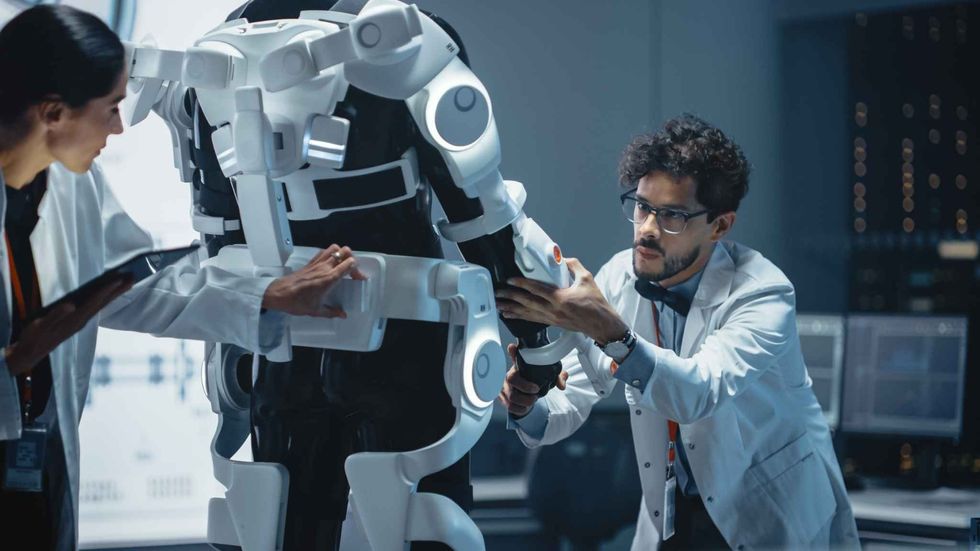Uses Of Machines
Let's look at some important uses of different types of simple machines:
Wedge: A wedge forces heavy objects or substances apart by applying force to a large area. A nail is a common wedge with force applied on the nail-head area and a small pointed area will exert force on the object.
As the force gets magnified at the fixed point, it is able to pierce into a wedge shape as the nail point moves forward and forces the wood apart. Axes, knives, and saws are every-day examples.
Wheel and Axle: The wheel and axle is a simple machine used to reduce friction in a moving object. A wide application is found in transportation. A wheel helps to overcome the friction much easier in making an object move. The wheel is fixed to rotate around an axle, and a car, bicycle, and hand trolley are every-day examples.
Lever: A load, fulcrum, and effort constitute a lever. The heavy objects are lifted by exerting force on one end of the lever and the turning point enables it to transmit to the load. See-saws, bottle openers, and hammers are every-day examples.
Inclined Plane: Using an inclined surface, an object can be lifted easily to a greater height and over longer distances with lesser force. In an inclined plane, lower force is to be applied for a longer distance, and sidewalk ramps and stairs are some common examples.
Screw: A screw is an inclined plane that is kind of wrapped around a shaft. The main two uses of screws are for holding things together and to lift light and heavy objects. In our every-day life, we use simple machine screws such as a bolt, screw, jar lid, spinning-stool screw, clamp, and car jack.
Pulley: Simple machines like pulleys are used to change the direction of a force acting on an object. A pulley consists of grooved wheels and a rope that can be used to act, capitalizing on the gravitational force (force acts) to pull down the rope and to lift up heavy objects.
Some every-day examples of fixed pulleys include elevators, cranes, rock-climbing gear, clothing lines, window blinds, fishing reels, flags and poles.
Amazing Facts About Simple Machines
Simple machines have amazed us with their capabilities and their simple yet complicated uses in complex machines. Well, here are some amazing simple machine facts that can make your life easier:
A stiff board on a base, called a fulcrum, acts as a lever.
A pulley is a combination of rope and wheel. It is used to pull things up and get them down.
A wedge with a pointed end cuts things. An ax is a great example of a wedge.
A wheel and an axle together form a simple machine that takes less effort and less energy to make things move.
Some examples of wheel and axle simple machines include drills, windmills, water wheels, and even the door handle!
An inclined plane is basically just a sloped surface. Further examples of inclined planes in every-day use are ramps, chisels, and hatchets.
A sidewalk near the stairs is an every-day example of an inclined plane that helps distribute load and has a downward force of gravity.
A rollercoaster uses the technique of inclined planes to take adventure seekers along the highs and lows of the ride.
Even a dump truck uses a wooden panel or a hard plate to take things into the truck, making use of the inclined plane to multiply force to lift the load into the truck.
When an inclined plane is wrapped around a rod to hold onto things tightly and securely, we call it a screw.
Every force that we exert on load, lever, wheels, rope, machines, and axles, for example, is just a push or a pull.
Did you know that magnetism is a type of force? Magnets push and pull other magnetic objects making a force work.
No force acts during inertia. The object's own weight or mass makes the object go slower.
Force and gravity were discovered first by Sir Isaac Newton. He studied various forces and distinguished three laws of motion connecting the force and the nature of objects.
The first law states that a body in motion continues to be in motion unless its inertia gradually slows down the force and makes the body stop.
A body in rest stays at rest unless an external force is applied to move or lift the object.
A force has the power to change the direction of the acting force or can change the speed of the body.
Finally, the third law explains the forces of nature and energy; for every action, there is an equal and opposite reaction for it.
All the elastic force and spring force that we use in machines are kinds of simple machine force.
One of the strongest forces in nature is the gravitational force.
The star neutron, which has collapsed, is said to have more magnetic force in this universe than anything else.
The tiny pointer arrow in the compass always points towards the north.
The first people tried to move a large heavy object using a long stick. That was how simple machines were discovered.
The six basic simple machines are wheel and axle, wedge, inclined plane, lever, screw, and pulley.
A fun fact about simple machines and complex machines is that all these basic simple machines are related to each other.
In order to do work, we need to exert force on the body or object.
And the amount of energy that is needed to lift the load or to move it to another direction or to get it to move to the other end is different for different bodies or objects with different mass and weight.
All these simple machines and their discoveries have made the workforce and work energy less to impart in order to pull or push or lift any load.
Also, many tools have been made to measure the amount of force on objects.
Complex machinery used in construction equipment and factories is made up of many simple machines.
Nail cutters are an example of simple machines that we use in our day-to-day life.
Simple machines are simple, and they can be found everywhere around us.
Simple machines are simple tools that multiply force and make things easier to work out on the other end with a smaller force.
It is hard to move or push a load on a flat surface. Therefore, people try to move the load by fitting it to some wheels or to keeping it on a wheel cart to move it more easily with less effort and less energy.
Most of the things that we see or use in our daily lives are simple machines or things that use those simple techniques.
On the other end, pulleys such as flagpoles and garbage doors are quite contrary examples of the same load lift and drop method of pulleys.
We can open modern jar lids using bottle openers and other simple machines. Otherwise, these jar lids would have demanded all our strength to open.
Even a pencil sharpener is an example of a simple machine.
A lift is a great example of the pulley system, giving a pull to people to load up buildings.
Did you know that a see-saw is an example of a lever?
The simple plane or straight plate connecting both ends is actually a lever with a point or a height right in the center of the plate or rod.
Other lever examples include pry bars.
A hammer is also a pretty cool lever example used in construction. A hammer, being a lever, helps to fit screws into walls. This makes it evident that simple machines depend on each other.
Moving office chairs with wheels on four sides is an every-day example of a simple machine.
The first discovery of a simple machine was made by the Greek philosopher Archimedes.
Ancient Egyptians were able to incorporate simple machines in the construction of their mighty pyramids.
Galileo became successful in figuring out a mathematical theory behind the working principle of a simple machine.
Did you know that your bicycle uses a different kind of simple machine to make it move or work?
Cave people discovered the simple technology of wheel and axle. Also, it is thought that the first people to invent the wheel and axle were the Sumerians 5,000 years ago.
A wheel and axle moves objects and bodies by reducing the friction and resistance through the force.
A great example of a wedge is a pair of scissors.
A pulley is a combination of simple machines like a wheel and a rope fixed on an axle.
The inclined plane can be considered as a ramp which makes it easier to move up heavy stuff. Also, we can use a lever in order to lift or pull up a load.
Simple machines change the direction of a force.
Simple machines can transfer the point of force from one end to another.
We can increase the magnitude or power of a force using simple machines.
Large force can be achieved by levering small force on a machine using the technique of a simple machine.
We can even try our best to increase the speed or direction of a body using a simple machine.
Simple machines are designed to make work easier.
The wedge has two sides, and one side of a wedge can be thick, while the other side of the wedge can be sharp. We use the sharp side of a wedge to cut or split through things.
Long-edged machines can make things easier than short-edged ones.
Wedges can be used for tightening things like screwdrivers.
We can also use a wedge to cut, and hold things.
In the Paleolithic era, people used wedges for hunting and carving stones, and cutting trees.
There are two different kinds of wedges used for different things. The two types of wedges are single wedge and double wedge. A single wedge example is an ax, and a double wedge example is a pair of scissors.
Screws tighten things into the wall or wood which makes them pretty solid.
The different types of screws available are bolts and drill bits.
A common wheel and axle use is for taking water from wells.
Wheel and axle methods can be used in the theater for stage curtains.
Just a small pull or push through the wheel with the rope can induce more power on the other rope in the wheel.
The two ways for a wheel and axle to work together is to induce force on both the wheel and axle.
A fishing rod is an example of a simple machine as it has a fishing reel, a lever, that has weight, a fulcrum, and applied force.









